Alcatel-Lucent OMNISWITCH 6800 Hardware Users Guide

Part No. 060196-10, Rev. G
June 2007
OmniSwitch 6800 Series
Hardware Users Guide
www.alcatel-lucent.com

This user guide documents OmniSwitch 6800 Series hardware, including chassis and associated components.
The specifications described in this guide are subject to change without notice.
Copyright © 2007 by Alcatel-Lucent. All rights reserved. This document may not be reproduced in whole or in part without the express written permission of Alcatel-Lucent.
Alcatel-Lucent® and the Alcatel-Lucent logo are registered trademarks of Alcatel-Lucent. Xylan®, OmniSwitch®, OmniStack®, and Alcatel-Lucent OmniVista® are registered trademarks of Alcatel-Lucent.
OmniAccess™, Omni Switch/Router™, PolicyView™, RouterView™, SwitchManager™, VoiceView™, WebView™, X-Cell™, X-Vision™, and the Xylan logo are trademarks of Alcatel-Lucent.
This OmniSwitch product contains components which may be covered by one or more of the following U.S. Patents:
•U.S. Patent No. 6,339,830
•U.S. Patent No. 6,070,243
•U.S. Patent No. 6,061,368
•U.S. Patent No. 5,394,402
•U.S. Patent No. 6,047,024
•U.S. Patent No. 6,314,106
•U.S. Patent No. 6,542,507
26801 West Agoura Road
Calabasas, CA 91301
(818) 880-3500 FAX (818) 880-3505 support@ind.alcatel.com
US Customer Support—(800) 995-2696 International Customer Support—(818) 878-4507 Internet—service.esd.alcatel-lucent.com
ii |
OmniSwitch 6800 Series Hardware Users Guide June 2007 |

Contents
|
About This Guide .......................................................................................................... |
ix |
|
Supported Platforms .......................................................................................................... |
ix |
|
Who Should Read this Manual? ......................................................................................... |
x |
|
When Should I Read this Manual? ..................................................................................... |
x |
|
What is in this Manual? ...................................................................................................... |
x |
|
What is Not in this Manual? ............................................................................................... |
x |
|
How is the Information Organized? .................................................................................. |
xi |
|
Documentation Roadmap .................................................................................................. |
xi |
|
Related Documentation ................................................................................................... |
xiii |
|
User Manual CD ............................................................................................................. |
xiv |
|
Technical Support ........................................................................................................... |
xiv |
Chapter 1 |
OmniSwitch 6800 Series ........................................................................................... |
1-1 |
|
Stacked Configurations ................................................................................................... |
1-3 |
|
Availability Features ....................................................................................................... |
1-4 |
|
Management Module Redundancy ........................................................................... |
1-4 |
|
Software Rollback .................................................................................................... |
1-5 |
|
Backup Power Supplies ............................................................................................ |
1-5 |
|
Hot Swapping ........................................................................................................... |
1-5 |
|
Hardware Monitoring ............................................................................................... |
1-6 |
|
Port and Fabric Capacities .............................................................................................. |
1-7 |
|
OmniSwitch 6800 Series Application Examples ............................................................ |
1-8 |
|
Gigabit-to-the-Desktop Migration ............................................................................ |
1-8 |
|
Server Aggregation .................................................................................................. |
1-9 |
|
Layer 3 Aggregation/Distribution .......................................................................... |
1-10 |
|
Small Enterprise Core ............................................................................................ |
1-11 |
Chapter 2 |
OmniSwitch 6800 Series Chassis and Hardware Components ..................... |
2-1 |
|
OmniSwitch 6800-24 ...................................................................................................... |
2-3 |
|
OmniSwitch 6800-48 ...................................................................................................... |
2-5 |
|
OmniSwitch 6800-U24 ................................................................................................... |
2-7 |
|
OmniSwitch 6800-24L .................................................................................................... |
2-9 |
|
OmniSwitch 6800-48L .................................................................................................. |
2-11 |
OmniSwitch 6800 Series Hardware Users Guide June 2007 |
iii |

|
Contents |
|
|
|
|
Status LEDs ................................................................................................................... |
2-13 |
10/100/1000 LEDs ................................................................................................. |
2-14 |
1000 SFP LEDs ...................................................................................................... |
2-14 |
10/100 LEDs .......................................................................................................... |
2-14 |
Rear Panel ..................................................................................................................... |
2-15 |
Mounting the Switch ..................................................................................................... |
2-16 |
Airflow Considerations .......................................................................................... |
2-16 |
Chassis Airflow ............................................................................................... |
2-17 |
Blank Cover Panels ................................................................................................ |
2-18 |
Installation Options ................................................................................................ |
2-19 |
Installing the Switch on a Tabletop or Bench ................................................. |
2-19 |
Rack-Mounting the Switch .............................................................................. |
2-20 |
Installing and Removing Combo Port SFPs ........................................................... |
2-21 |
Setting Up a Stacked Configuration .............................................................................. |
2-22 |
Rack Mounting Stacked Configurations ................................................................ |
2-22 |
Cabling Stacked Configurations ............................................................................. |
2-22 |
Redundant Stacking Cable Connections ......................................................... |
2-22 |
Supported Cabling Patterns ............................................................................. |
2-22 |
Booting OmniSwitch 6800 Series Switches ................................................................. |
2-25 |
Booting a Stand-alone Switch ................................................................................ |
2-25 |
Booting Stacked Configurations ............................................................................ |
2-26 |
Power Cords .................................................................................................................. |
2-27 |
Console Port .................................................................................................................. |
2-28 |
Serial Connection Default Settings ........................................................................ |
2-28 |
Modifying the Serial Connection Settings ............................................................. |
2-28 |
Console Port Pinouts .............................................................................................. |
2-30 |
RJ-45 Console Port – Connector Pinout .......................................................... |
2-30 |
Monitoring the Chassis ................................................................................................. |
2-31 |
Checking Overall Chassis Status ............................................................................ |
2-31 |
Checking Temperature Status ................................................................................ |
2-31 |
Checking Fan Status ............................................................................................... |
2-32 |
Checking Power Supply Status .............................................................................. |
2-32 |
Additional Monitoring Commands ........................................................................ |
2-32 |
Using LEDs to Visually Monitor the Chassis ........................................................ |
2-33 |
OS6800-XNI-U2 10 Gigabit Expansion Module .......................................................... |
2-34 |
10 Gigabit Slot and Port Numbering ............................................................... |
2-35 |
10 Gigabit Expansion Modules and Token Usage .......................................... |
2-35 |
10 GigE Interoperability Between OS6800 and OS8800 Switches ................ |
2-36 |
Installing 10 Gigabit Expansion Modules .............................................................. |
2-37 |
Removing 10 Gigabit Modules .............................................................................. |
2-38 |
Blank Cover Panel Requirement ..................................................................... |
2-38 |
Installing SFP and XFP Transceivers ..................................................................... |
2-39 |
iv |
OmniSwitch 6800 Series Hardware Users Guide June 2007 |

Contents
|
|
|
|
|
|
|
..............................................................................Backup Power Supply Components |
2-39 |
|
OS6800-BPS-SHLF Backup Power Supply Shelf ................................................. |
2-40 |
|
OS6800-BPS-SHLF Backup Power Shelf Specifications ............................... |
2-41 |
|
OS6800-BPS-225 225W Backup Power Supply ................................................... |
2-42 |
|
OS6800-BPS-225 225W Backup Power Supply Specifications ..................... |
2-43 |
|
Rack-Mounting the OS6800-BPS-SHLF Power Shelf .......................................... |
2-44 |
|
Installing a Backup Power Supply In the Power Shelf .......................................... |
2-46 |
|
Installing the Backup Power Supply Daughtercard ............................................... |
2-48 |
|
Installing the Backup Power Supply Connector Cables ......................................... |
2-48 |
|
Powering on the Backup Power Supplies .............................................................. |
2-48 |
|
Removing a Backup Power Supply ........................................................................ |
2-49 |
|
Removing the Backup Power Supply Daughtercard .............................................. |
2-51 |
|
Blank Cover Panel Requirement ............................................................................ |
2-51 |
|
Backup Power Supply Pinouts ...................................................................................... |
2-52 |
|
Viewing Primary and Backup Power Supply Status ..................................................... |
2-53 |
|
Viewing Power Supply Status for Stacked Configurations ................................... |
2-53 |
|
A Slot Number is Specified ............................................................................. |
2-53 |
|
No Slot Number is Specified ........................................................................... |
2-54 |
Chapter 3 |
Managing OmniSwitch 6800 Series Stacks ........................................................ |
3-1 |
|
In This Chapter ................................................................................................................ |
3-1 |
|
OmniSwitch 6800 Series Stack Overview ...................................................................... |
3-2 |
|
Roles Within the Stack .................................................................................................... |
3-2 |
|
Primary and Secondary Management Modules ....................................................... |
3-2 |
|
Primary Management Module Selection ........................................................... |
3-5 |
|
Secondary Management Module Selection ....................................................... |
3-8 |
|
Idle Module Role .................................................................................................... |
3-10 |
|
Pass-Through Mode ............................................................................................... |
3-11 |
|
Recovering from Pass-Through Mode (Duplicate Slot Numbers) .................. |
3-12 |
|
Stack Cabling ................................................................................................................ |
3-15 |
|
Redundant Stacking Cable Connection .................................................................. |
3-16 |
|
Checking Redundant Stacking Cable Status .......................................................... |
3-17 |
|
Slot Numbering ............................................................................................................. |
3-18 |
|
Dynamic Slot Number Assignment ........................................................................ |
3-18 |
|
Manual Slot Number Assignment .......................................................................... |
3-20 |
|
Reverting to the Dynamic Slot Numbering Model .......................................... |
3-21 |
|
Hot-Swapping Modules In a Stack ............................................................................... |
3-22 |
|
Removing Switches from an Existing Stack .......................................................... |
3-22 |
|
Inserting Switches Into an Existing Stack .............................................................. |
3-22 |
|
Merging Stacks ....................................................................................................... |
3-23 |
|
Understanding Tokens .................................................................................................. |
3-24 |
|
Checking Tokens Currently Used In a Stack ......................................................... |
3-24 |
OmniSwitch 6800 Series Hardware Users Guide June 2007 |
v |

|
|
Contents |
|
|
|
|
|
|
|
Reloading Switches ....................................................................................................... |
3-25 |
|
Reloading the Primary Management Module ........................................................ |
3-25 |
|
Reloading the Secondary Management Module .................................................... |
3-27 |
|
Reloading Switches with Idle Roles ....................................................................... |
3-29 |
|
Reloading Switches in Pass-Through Mode .......................................................... |
3-29 |
|
Reloading All Switches in a Stack ......................................................................... |
3-30 |
|
Software Synchronization During a Full Reload ............................................. |
3-30 |
|
Effects of Saved Slot Number Information on the Reload Process ................. |
3-30 |
|
Avoiding Split Stacks ............................................................................................. |
3-32 |
|
Changing the Secondary Module to Primary ................................................................ |
3-33 |
|
Synchronizing Switches in a Stack ............................................................................... |
3-35 |
|
Automatic Synchronization During a Full Reload ................................................. |
3-35 |
|
Monitoring the Stack ..................................................................................................... |
3-36 |
|
Visually Monitoring the Stack ............................................................................... |
3-36 |
|
CLI Commands Supported on Both Primary and Secondary |
|
|
Management Modules ............................................................................................ |
3-37 |
Appendix A |
Regulatory Compliance and Safety Information .............................................. |
A-1 |
|
Declaration of Conformity: CE Mark ............................................................................ |
A-1 |
|
Waste Electrical and Electronic Equipment (WEEE) Statement ............................ |
A-1 |
|
China RoHS: Hazardous Substance Table ..................................................................... |
A-2 |
|
Standards Compliance .................................................................................................... |
A-4 |
|
FCC Class A, Part 15 .............................................................................................. |
A-5 |
|
Canada Class A Statement ...................................................................................... |
A-5 |
|
JATE ........................................................................................................................ |
A-5 |
|
CISPR22 Class A warning ...................................................................................... |
A-5 |
|
VCCI ....................................................................................................................... |
A-6 |
|
Class A Warning for Taiwan and Other Chinese Markets ...................................... |
A-6 |
|
Translated Safety Warnings ........................................................................................... |
A-7 |
|
Chassis Lifting Warning ................................................................................... |
A-7 |
|
Blank Panels Warning ...................................................................................... |
A-7 |
|
Electrical Storm Warning ................................................................................. |
A-7 |
|
Installation Warning ......................................................................................... |
A-8 |
|
Invisible Laser Radiation Warning ................................................................... |
A-8 |
|
Lithium Battery Warning ................................................................................. |
A-9 |
|
Operating Voltage Warning ............................................................................. |
A-9 |
|
Power Disconnection Warning ....................................................................... |
A-10 |
|
Proper Earthing Requirement Warning .......................................................... |
A-10 |
|
Read Important Safety Information Warning ................................................. |
A-11 |
|
Restricted Access Location Warning ............................................................. |
A-11 |
|
Wrist Strap Warning ....................................................................................... |
A-12 |
vi |
OmniSwitch 6800 Series Hardware Users Guide June 2007 |

Contents
|
|
|
|
.........................................................................Instrucciones de seguridad en español |
A-13 |
Advertencia sobre el levantamiento del chasis ............................................... |
A-13 |
Advertencia de las tapaderas en blanco .......................................................... |
A-13 |
Advertencia en caso de tormenta eléctrica ..................................................... |
A-13 |
Advertencia de instalación ............................................................................. |
A-13 |
Advertencia de radiación láser invisible ......................................................... |
A-13 |
Advertencia de la batería de litio .................................................................... |
A-13 |
Advertencia sobre la tensión de operación ..................................................... |
A-13 |
Advertencia sobre la desconexión de la fuente .............................................. |
A-13 |
Advertencia sobre una apropiada conexión a tierra ....................................... |
A-14 |
Leer “información importante de seguridad” ................................................. |
A-14 |
Advertencia de acceso restringido .................................................................. |
A-14 |
Advertencia de pulsera antiestática ................................................................ |
A-14 |
Clase de seguridad .......................................................................................... |
A-14 |
Index ...................................................................................................................... |
Index-1 |
OmniSwitch 6800 Series Hardware Users Guide June 2007 |
vii |
Contents
|
|
|
|
|
|
viii |
OmniSwitch 6800 Series Hardware Users Guide June 2007 |

About This Guide
This OmniSwitch 6800 Series Hardware Users Guide describes your switch hardware components and basic switch hardware procedures.
Supported Platforms
The information in this guide applies to the following products:
•OmniSwitch 6800-24
•OmniSwitch 6800-48
•OmniSwitch 6800-U24
•OmniSwitch 6800-24L
•OmniSwitch 6800-48L
Unsupported Platforms
The information in this guide does not apply to the following products:
•OmniSwitch (original version with no numeric model name)
•OmniSwitch 6624
•OmniSwitch 6648
•OmniSwitch 6600-U24
•OmniSwitch 6600-P24
•OmniSwitch 6602-24
•OmniSwitch 6602-48
•OmniSwitch 7700
•OmniSwitch 7800
•OmniSwitch 8800
•Omni Switch/Router
•OmniStack
•OmniAccess
OmniSwitch 6800 Series Hardware Users Guide June 2007 |
page ix |

Who Should Read this Manual? |
About This Guide |
|
|
|
|
Who Should Read this Manual?
The audience for this users guide is network administrators and IT support personnel who need to configure, maintain, and monitor switches and routers in a live network. However, anyone wishing to gain knowledge on the OmniSwitch 6800 Series hardware will benefit from the material in this guide.
When Should I Read this Manual?
Read this guide as soon as you are ready to familiarize yourself with your switch hardware components. You should have already stepped through the first login procedures and read the brief hardware overviews in the OmniSwitch 6800 Series Getting Started Guide.
You should already be familiar with the very basics of the switch hardware, such as module LEDs and module installation procedures. This manual will help you understand your switch hardware components (e.g., chassis, stacking ports and cables, backup power supplies, etc.) in greater depth.
What is in this Manual?
This users guide includes the following hardware-related information:
•Descriptions of stand-alone and stacked configurations.
•Descriptions of “availability” features.
•Descriptions of chassis types (OS6800-24 and OS6800-48).
•Instructions for mounting the chassis.
•Descriptions of hardware components (status LEDs, chassis, stacking ports and cables, backup power supplies, etc.).
•Managing a stand-alone chassis.
•Setting up stacks.
•Managing stacks.
•Hardware-related Command Line Interface (CLI) commands.
What is Not in this Manual?
The descriptive and procedural information in this manual focuses on switch hardware. It includes information on some CLI commands that pertain directly to hardware configuration, but it is not intended as a software users guide. There are several OmniSwitch 6800 Series users guides that focus on switch software configuration. Consult those guides for detailed information and examples for configuring your switch software to operate in a live network environment. See “Documentation Roadmap” on page -xi and “Related Documentation” on page -xiii for further information on software configuration guides available for your switch.
page x |
OmniSwitch 6800 Series Hardware Users Guide June 2007 |

About This Guide |
How is the Information Organized? |
|
|
|
|
How is the Information Organized?
This users guide provides an overview of OmniSwitch 6800 Series switches in the first chapter, an overview and procedures for setting up and managing OmniSwitch 6800 Series switches in the second chapter, and an overview and procedures for managing stacks in the third chapter.
Documentation Roadmap
The OmniSwitch user documentation suite was designed to supply you with information at several critical junctures of the configuration process.The following section outlines a roadmap of the manuals that will help you at each stage of the configuration process. Under each stage, we point you to the manual or manuals that will be most helpful to you.
Stage 1: Using the Switch for the First Time
Pertinent Documentation: OmniSwitch 6800 Series Getting Started Guide
Release Notes
The OmniSwitch 6800 Series Getting Started Guide provides all the information you need to get your switch up and running the first time. This guide provides information on unpacking the switch, rack mounting the switch, installing stacking cables, installing backup power supplies, unlocking access control, setting the switch’s IP address, setting up a password, and setting up stacks. It also includes succinct overview information on fundamental aspects of the switch, such as hardware LEDs, the software directory structure, stacking, CLI conventions, and web-based management.
At this time you should also familiarize yourself with the Release Notes that accompanied your switch. This document includes important information on feature limitations that are not included in other user guides.
Stage 2: Gaining Familiarity with Basic Switch Functions
Pertinent Documentation: OmniSwitch 6800 Series Hardware Users Guide
OmniSwitch 6800/6850/9000 Series Switch Management Guide
Once you have your switch up and running, you will want to begin investigating basic aspects of its hardware and software. Information about switch hardware is provided in the OmniSwitch 6800 Series Hardware Users Guide. This guide provide specifications, illustrations, and descriptions of all hardware components—e.g., chassis, stacking ports and stacking cables, backup power supplies, etc. It also includes steps for common procedures, such as removing and installing switch modules.
The OmniSwitch 6800/6850/9000 Switch Management Guide is the primary user guide for the basic software features on a single switch. This guide contains information on the switch directory structure, basic file and directory utilities, switch access security, SNMP, and web-based management. It is recommended that you read this guide before connecting your switch to the network.
OmniSwitch 6800 Series Hardware Users Guide June 2007 |
page xi |

Documentation Roadmap |
About This Guide |
|
|
|
|
Stage 3: Integrating the Switch Into a Network
Pertinent Documentation: OmniSwitch 6800/6850/9000 Network Configuration Guide OmniSwitch 6800/6850/9000 Advanced Routing Configuration Guide
When you are ready to connect your switch to the network, you will need to learn how the OmniSwitch implements fundamental software features, such as 802.1Q, VLANs, and Spanning Tree. The OmniSwitch 6800/6850/9000 Network Configuration Guide contains overview information, procedures and examples on how standard networking technologies are configured in the OmniSwitch 6800 Series.
The OmniSwitch 6800/6850/9000 Advanced Routing Configuration Guide includes configuration information for networks using Open Shortest Path First (OSPF).
Anytime
The OmniSwitch CLI Reference Guide contains comprehensive information on all CLI commands supported by the switch. This guide includes syntax, default, usage, example, related CLI command, and CLI-to-MIB variable mapping information for all CLI commands supported by the switch. This guide can be consulted anytime during the configuration process to find detailed and specific information on each CLI command.
page xii |
OmniSwitch 6800 Series Hardware Users Guide June 2007 |

About This Guide |
Related Documentation |
|
|
|
|
Related Documentation
The following are the titles and descriptions of all the OmniSwitch 6800 Series user manuals:
•OmniSwitch 6800 Series Getting Started Guide
Describes the hardware and software procedures for getting an OmniSwitch 6800 Series switch up and running. Also provides information on fundamental aspects of OmniSwitch software and stacking architecture.
•OmniSwitch 6800 Series Hardware Users Guide
Detailed technical specifications and procedures for the OmniSwitch 6800 Series chassis and components. This manual also includes comprehensive information on assembling and managing stacked configurations.
•OmniSwitch CLI Reference Guide
Complete reference to all CLI commands supported on OmniSwitch 6800, 6850, and 9000 Series switches. Includes syntax definitions, default values, examples, usage guidelines and CLI-to-MIB variable mappings.
•OmniSwitch 6800/6850/9000 Switch Management Guide
Includes procedures for readying an individual switch for integration into a network. Topics include the software directory architecture, image rollback protections, authenticated switch access, managing switch files, system configuration, using SNMP, and using web management software (WebView).
•OmniSwitch 6800/6850/9000 Network Configuration Guide
Includes network configuration procedures and descriptive information on all the major software features and protocols included in the base software package. Chapters cover Layer 2 information (Ethernet and VLAN configuration), Layer 3 information, security options (authenticated VLANs), Quality of Service (QoS), and link aggregation.
•OmniSwitch 6800/6850/9000 Advanced Routing Configuration Guide
Includes network configuration procedures and descriptive information on all the software features and protocols included in the advanced routing software package. Chapters cover multicast routing (DVMRP and PIM-SM), and OSPF.
•OmniSwitch Transceivers Guide
Includes SFP and XFP transceiver specifications and product compatibility information.
•Technical Tips, Field Notices
Includes information published by Alcatel-Lucent’s Customer Support group.
•Release Notes
Includes critical Open Problem Reports, feature exceptions, and other important information on the features supported in the current release and any limitations to their support.
OmniSwitch 6800 Series Hardware Users Guide June 2007 |
page xiii |

User Manual CD |
About This Guide |
|
|
|
|
User Manual CD
All user guides for the OmniSwitch 6800 Series are included on the User Manual CD. This CD also includes user guides for other Alcatel-Lucent data enterprise products. In addition, it contains a stand-alone version of the on-line help system that is embedded in the OmniVista network management application.
Besides the OmniVista documentation, all documentation on the User Manual CD is in PDF format and requires the Adobe Acrobat Reader program for viewing. Acrobat Reader freeware is available at www.adobe.com.
Note. In order to take advantage of the documentation CD’s global search feature, it is recommended that you select the option for searching PDF files before downloading Acrobat Reader freeware.
To verify that you are using Acrobat Reader with the global search option, look for the following button in the toolbar:
Note. When printing pages from the documentation PDFs, deselect Fit to Page if it is selected in your print dialog. Otherwise pages may print with slightly smaller margins.
Technical Support
An Alcatel-Lucent service agreement brings your company the assurance of 7x24 no-excuses technical support. You’ll also receive regular software updates to maintain and maximize your Alcatel-Lucent product’s features and functionality and on-site hardware replacement through our global network of highly qualified service delivery partners. Additionally, with 24-hour-a-day access to Alcatel-Lucent’s Service and Support web page, you’ll be able to view and update any case (open or closed) that you have reported to Alcatel-Lucent’s technical support, open a new case or access helpful release notes, technical bulletins, and manuals. For more information on Alcatel-Lucent’s Service Programs, see our web page at service.esd.alcatel-lucent.com, call us at 1-800-995-2696, or email us at support@ind.alcatel.com.
page xiv |
OmniSwitch 6800 Series Hardware Users Guide June 2007 |
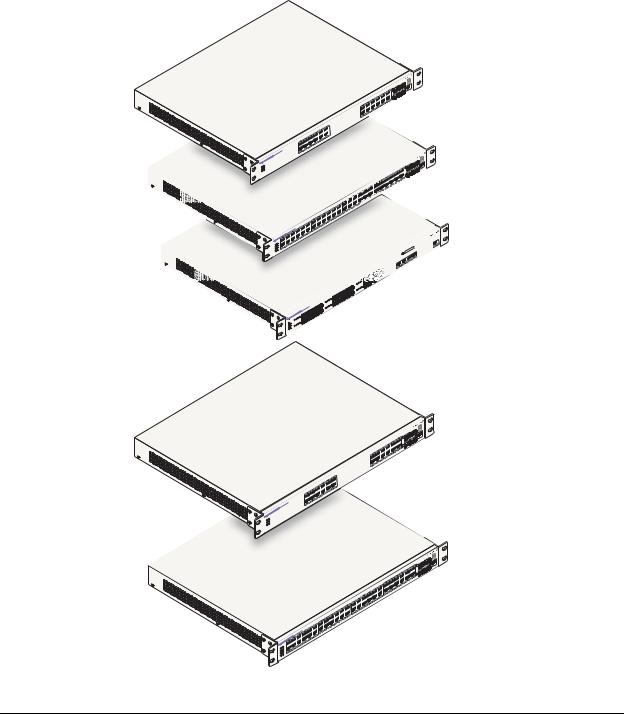
1 OmniSwitch 6800 Series
The OmniSwitch 6800 Series is an advanced fixed configuration family of Ethernet switches. These switches provide wire rate layer-2 forwarding and layer-3 routing with advanced services.
OmniSwitch 6800-24
OmniSwitch 6800-48
OmniSwitch 6800-U24
OmniSwitch 6800-24L
OmniSwitch 6800-48L
OmniSwitch 6800 Series Hardware Users Guide June 2007 |
page 1-1 |

OmniSwitch 6800 Series
•The OmniSwitch 6800-24 (OS6800-24) is a 24 port, 10/100/1000 fixed stackable chassis.
•The OmniSwitch 6800-48 (OS6800-48) is a 48 port, 10/100/1000 fixed stackable chassis. This switch also supports a 10 Gigabit uplink module.
•The OmniSwitch 6800-U24 (OS6800-U24) is a 24 fiber 1000 Mbps SFP connector chassis. This switch also supports a 10 Gigabit uplink module.
•The OmniSwitch 6800-24L (OS6800-24L) is a 24 port fixed stackable chassis. This chassis has 20 unshared 10/100 ports, which can be upgraded to 10/100/1000 ports.
•The OmniSwitch 6800-48L (OS6800-48L) is a 48 port fixed stackable chassis. This chassis has 44 unshared 10/100 ports, which can be upgraded to 10/100/1000 ports.
Whether operating as a single switch or as a stack, the OmniSwitch 6800 Series offers effective availability, resiliency, and security features and are ideal for the following network applications:
•Enterprise workgroups/LAN wiring closets
•Edge deployments and branch offices
•L3 aggregation/distribution layer switches in three-tier networks
•Small enterprise core switching
•Quality of service (QoS) for mission critical applications
•Data center server clusters
Note on Terminology. In the user guides provided with your OmniSwitch 6800 Series switch, the terms stack and virtual chassis are interchangeable terms referring to OmniSwitch 6800 Series switches in a stacked configuration. The terms module, switch, slot and element are used to refer to individual switches within a stacked configuration. The terms Chassis Management Module (CMM) and management module refer to those switches operating in a stack either in primary or secondary management roles. OmniSwitch 6800 Series switches operating in an idle role are essentially acting as network interface modules and therefore may be referred to as Network Interfaces (NIs).
page 1-2 |
OmniSwitch 6800 Series Hardware Users Guide June 2007 |
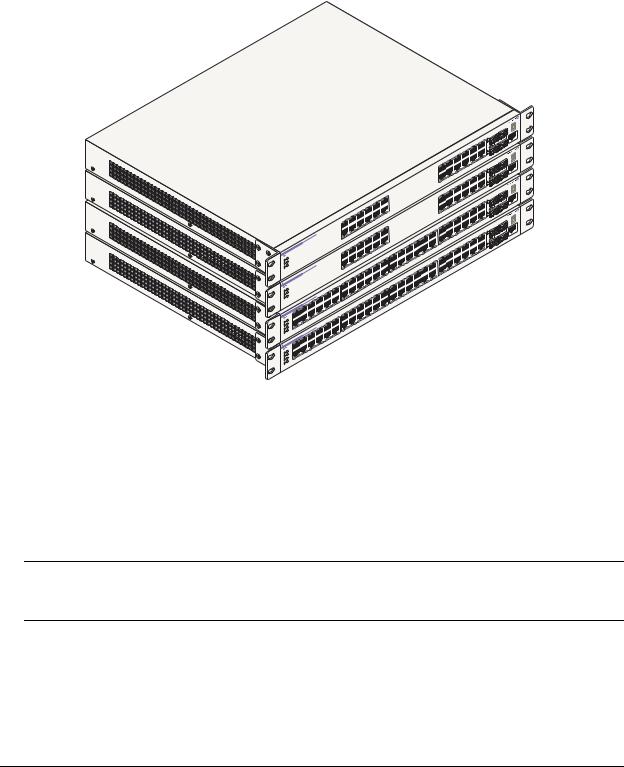
OmniSwitch 6800 Series |
Stacked Configurations |
|
|
|
|
Stacked Configurations
In addition to working as individual, stand-alone switches, OmniSwitch 6800 Series switches (except for the OS6800-U24) can also be linked together to form a single, high-density virtual chassis known as a stack.
|
|
|
|
|
|
|
|
|
|
|
|
|
23 |
|
|
|
|
|
|
|
|
|
|
|
|
|
21 |
|
|
|
|
|
|
|
|
|
|
|
|
|
K/ACT |
|
|
|
|
|
|
|
|
|
|
|
|
23 LIN |
|
|
|
|
|
|
|
|
|
|
|
|
|
21 |
|
|
|
|
|
|
|
|
|
|
|
|
19 |
|
24 |
|
|
|
|
|
|
|
|
|
|
|
17 |
|
22 |
|
|
|
|
|
|
|
|
|
|
|
|
|
K/ACT |
|
|
|
|
|
|
|
|
|
|
15 |
|
24 LIN |
|
|
|
|
|
|
|
|
|
|
|
13 |
|
22 |
|
|
|
|
|
|
|
|
|
|
|
|
20 |
|
|
|
|
|
|
|
|
|
|
|
|
|
18 |
|
|
|
|
|
|
|
|
|
|
|
|
16 |
|
|
|
|
|
|
|
|
|
|
|
|
|
14 |
|
|
|
|
|
|
|
|
|
|
|
11 |
|
|
|
|
|
|
|
|
|
|
|
|
9 |
|
|
|
|
|
K/ACT |
|
|
|
|
|
|
|
|
|
|
|
|
47 LIN |
|
|
|
|
|
|
|
7 |
|
|
|
|
|
45 |
|
|
|
|
|
|
|
5 |
|
|
|
|
43 |
|
|
|
|
|
|
|
|
3 |
|
12 |
|
|
41 |
|
|
|
|
|
|
Speed |
1 |
|
10 |
|
|
|
|
|
K/ACT |
|
|
|
|
|
|
|
|
|
39 |
|
48 LIN |
||
|
|
|
|
|
|
8 |
|
|
|
37 |
|
46 |
|
|
|
|
|
|
|
6 |
|
|
|
35 |
44 |
|
CT |
|
|
|
|
|
|
|
|
|
|
|
|
||
|
|
|
|
|
|
4 |
|
|
|
|
42 |
47 |
LINK/A |
|
|
|
|
|
|
|
|
|
|
33 |
|
||
|
|
|
|
Speed |
2 |
|
|
|
|
40 |
|
45 |
|
|
|
|
|
|
|
|
|
31 |
|
|
|
||
|
|
|
-24 |
|
|
|
|
29 |
|
38 |
43 |
|
|
|
|
6800 |
|
|
|
|
|
|
|
|
|
||
|
OmniSwitch |
|
|
|
|
|
|
|
39 |
41 |
|
LINK/A |
|
|
|
|
|
|
|
|
|
27 |
|
36 |
|
|
CT |
|
|
|
|
|
|
8 |
|
25 |
|
34 |
|
48 |
|
|
PRI |
|
|
|
|
|
|
32 |
37 |
|
46 |
|
|
|
|
|
|
|
6 |
|
23 |
|
44 |
|
|
||
OK |
BPS |
|
|
|
|
|
|
|
35 |
|
|
||
|
|
|
|
|
21 |
30 |
|
|
|
|
|||
PWR |
P |
|
|
|
|
4 |
|
|
|
42 |
|
|
|
TM |
|
|
|
|
|
|
28 |
|
33 |
|
|
||
FAN |
|
|
|
Speed |
2 |
19 |
|
|
|
40 |
|
|
|
|
|
|
|
|
|
|
26 |
31 |
|
|
|
||
|
|
|
|
|
|
17 |
|
|
|
|
|
|
|
|
|
|
-24 |
|
|
|
|
29 |
|
38 |
|
|
|
|
OmniSwitch |
6800 |
|
|
13 |
15 |
22 |
24 |
|
|
|
|
|
|
|
|
|
|
27 |
|
36 |
|
|
|
|||
|
|
|
|
|
|
|
|
25 |
|
34 |
|
|
|
|
PRI |
|
|
11 |
|
20 |
|
|
32 |
|
|
|
|
|
|
|
|
|
18 |
|
23 |
|
|
|
|
||
OK |
BPS |
|
|
9 |
|
|
30 |
|
|
|
|
|
|
|
|
|
|
|
21 |
|
|
|
|
|
|||
PWR |
P |
|
|
|
|
16 |
|
|
|
|
|
|
|
TM |
|
|
7 |
|
|
28 |
|
|
|
|
|
||
FAN |
|
|
|
|
14 |
19 |
|
|
|
|
|
|
|
|
|
5 |
|
|
|
|
|
|
|
|
|
||
|
|
|
|
|
|
17 |
|
26 |
|
|
|
|
|
|
|
|
3 |
12 |
|
|
|
|
|
|
|
|
|
|
|
6800 |
-48 |
|
|
15 |
|
24 |
|
|
|
|
|
|
OmniSwitch |
d |
1 |
10 |
|
|
|
|
|
|
|
|
|
|
Spee |
|
8 |
13 |
|
22 |
|
|
|
|
|
|
|
|
|
|
|
11 |
|
20 |
|
|
|
|
|
|
|
|
PRI |
|
6 |
|
|
|
|
|
|
|
|
|
|
OK |
BPS |
|
4 |
9 |
|
18 |
|
|
|
|
|
|
|
PWR |
TMP |
|
|
7 |
|
16 |
|
|
|
|
|
|
|
ed |
2 |
|
|
|
|
|
|
|
|
|
|||
|
2 |
|
|
|
|
|
|
|
|
|
|
||
FAN |
XFP |
Spe |
5 |
|
14 |
|
|
|
|
|
|
|
|
XFP1 |
|
|
|
12 |
|
|
|
|
|
|
|
|
|
|
|
|
3 |
|
|
|
|
|
|
|
|
|
|
|
|
|
-48 |
|
|
|
|
|
|
|
|
|
|
|
OmniSwitch |
68001 |
10 |
|
|
|
|
|
|
|
|
|
|
|
Speed |
|
8 |
|
|
|
|
|
|
|
|
|
|
|
PRI |
|
6 |
|
|
|
|
|
|
|
|
|
|
OK |
BPS |
|
4 |
|
|
|
|
|
|
|
|
|
|
PWR |
P |
|
|
|
|
|
|
|
|
|
|
|
|
TM |
ed |
2 |
|
|
|
|
|
|
|
|
|
|
|
|
2 |
|
|
|
|
|
|
|
|
|
|
||
FAN |
XFP |
Spe |
|
|
|
|
|
|
|
|
|
|
|
XFP1 |
|
|
|
|
|
|
|
|
|
|
|
|
|
Console
OmniSwitch 6800 Series Stacked Configuration (Stack of Four Shown)
Stacking switches provides scalability by allowing users to quickly and easily expand 10/100/1000 port density. Twenty-four 10/100/1000 ports are added for each OS6800-24 brought into the stack and forty-eight 10/100/1000 ports are added for each OS6800-48.
Up to eight switches can be stacked. OmniSwitch 6800 Series switches can be mixed and matched in any combination within the stack. This provides a virtual chassis with a 10/100/1000 capacity of up to 384 ports.
Note. Other stackable Alcatel-Lucent products, such as the OmniSwitch 6600 Series switch, cannot be added to an OmniSwitch 6800 Series virtual chassis. For comprehensive information on managing stacked configurations, refer to Chapter 3, “Managing OmniSwitch 6800 Series Stacks.”
OmniSwitch 6800 Series Hardware Users Guide June 2007 |
page 1-3 |

Availability Features |
OmniSwitch 6800 Series |
|
|
|
|
Availability Features
The switch provides a broad variety of availability features. Availability features are hardware and software-based safeguards that help prevent the loss of data flow in the unlikely event of a subsystem failure. In addition, some availability features allow users to maintain or replace hardware components without powering off the switch or interrupting switch operations. Combined, these features provide added resiliency and help ensure that the switch or virtual chassis is consistently available for day-to-day network operations.
Hardware-related Availability features include:
•Management Module Redundancy
•Software Rollback
•Backup Power Supplies
•Hot Swapping
•Hardware Monitoring
Management Module Redundancy
In stacked configurations, one OmniSwitch 6800 Series switch is designated as the primary “management module” for the stack. Because the stack can be thought of as a virtual chassis, the role of this primary management switch is to monitor and manage the functions of the stack.
Similar to chassis-based switches, such as the OmniSwitch 9700 and Omniswitch 9800, the stack also allows users to assign an additional switch as a secondary management module. As with the OS9700 and OS9800, the stack’s secondary switch immediately takes over management functions in the event of a primary switch failure.
All other switches in the stack are considered idle, and act very much like Network Interface (NI) modules, in that they provide Ethernet ports for 10/100/1000 traffic.
The stack provides support for all idle switches during primary-to-secondary failover. In other words, if the stack’s primary switch fails or goes offline for any reason, all idle switches will continue data transmission during the secondary switch’s takeover process.
Incoming Layer 2 packets will continue to be sent to the appropriate egress port during failover. Spanning Tree will continue handling BPDUs received on the switch ports, as well as port link up and down states. The Spanning Tree topology will not be disrupted.
Note. For detailed information on primary, secondary, and idle switches, as well as the failover process, refer to Chapter 3, “Managing OmniSwitch 6800 Series Stacks.”
page 1-4 |
OmniSwitch 6800 Series Hardware Users Guide June 2007 |

OmniSwitch 6800 Series |
Availability Features |
|
|
|
|
Software Rollback
Software rollback (also referred to as image rollback) essentially allows the OmniSwitch 6800 Series switches (in both standalone and stacked configurations) to return to a prior “last known good” version of software in the event of a system software problem. The switch controls software rollback through its resilient directory structure design (i.e., /flash/working and /flash/certified).
For detailed information on the software rollback feature, as well as the switch’s /flash/working and /flash/certified directories, refer to the “Managing CMM Directory Content” chapter in the OmniSwitch 6800/6850/9000 Switch Management Guide.
Backup Power Supplies
OmniSwitch 6800 Series switches support an optional backup power supply shelf. The backup power supply shelf is a separate, rack-mountable chassis offering power supply bays for up to eight 225 watt power supply modules. This provides redundant chassis power on a 1:1 basis.
Backup power supplies operate in active standby mode. If the primary power supply fails unexpectedly, the backup power supply automatically takes up the full power load without disrupting the switch.
Note. For more information on backup power supplies, refer to Chapter 2, “OmniSwitch 6800 Series Chassis and Hardware Components.”
Hot Swapping
Hot swapping refers to the action of adding, removing, or replacing components without powering off switches or disrupting other components in the switch or stack. This feature facilitates hardware upgrades and maintenance and allows users to easily replace components in the unlikely event of hardware failure.
The following hardware components can be hot swapped:
•OS6800-BPS-225 backup power supplies
•Backup power supply connector cables
•Backup power supply daughtercard module
•SFPs
•Modules operating in idle status within a stacked configuration (see Chapter 3, “Managing OmniSwitch 6800 Series Stacks.”)
•Stacking cables (see note below)
Note. Stacking cables can be hot swapped as long as the stack is not split into two or more separate stacks in the process. In addition, a redundant cable connection must always be in place before swapping stacking cables. Otherwise, stack operations may be disrupted. For information on stacking cables, refer to Chapter 2, “OmniSwitch 6800 Series Chassis and Hardware Components.”
For instructions on hot swapping backup power supplies, refer to Chapter 2, “OmniSwitch 6800 Series Chassis and Hardware Components.” For instructions on hot swapping combo port SFPs, refer to the instruction card provided with the SFP product. For instructions on hot swapping modules within a stacked configuration, refer to Chapter 3, “Managing OmniSwitch 6800 Series Stacks.”
OmniSwitch 6800 Series Hardware Users Guide June 2007 |
page 1-5 |

Availability Features |
OmniSwitch 6800 Series |
|
|
|
|
Hardware Monitoring
Automatic Monitoring
Automatic monitoring refers to the switch’s built-in sensors that automatically monitor operations. If an error is detected (e.g., over-threshold temperature), the switch immediately sends a trap to the user. The trap is displayed on the console in the form of a text error message. (In the case of an over-threshold temperature condition, the chassis displays an amber TMP LED in addition to sending a trap.)
LEDs
LEDs, which provide visual status information, are provided on the chassis front panel. LEDs are used to indicate conditions such as hardware and software status, temperature errors, link integrity, data flow, etc. For detailed LED descriptions, refer to Chapter 2, “OmniSwitch 6800 Series Chassis and Hardware Components.”
User-Driven Monitoring
User-driven hardware monitoring refers to CLI commands that are entered by the user in order to access the current status of hardware components. The user enters “show” commands that output information to the console. Monitoring information for chassis components such as the optional back up power supply, chassis temperature sensor, and chassis fans is provided in Chapter 2, “OmniSwitch 6800 Series Chassis and Hardware Components.” Show commands for all features are described in detail in the OmniSwitch CLI Reference Guide.
page 1-6 |
OmniSwitch 6800 Series Hardware Users Guide June 2007 |

OmniSwitch 6800 Series |
Port and Fabric Capacities |
|
|
|
|
Port and Fabric Capacities
OmniSwitch 6800 Series switches offer 20 non combo 10/100/1000 Ethernet ports, 44 non combo 10/100/1000 Ethernet ports, 20 non combo 1000 Mbps SFP connectors, 20 non combo 10/100 Ethernet ports, or 44 non combo 10/100 Ethernet ports. The switches also offer combo ports, which consist of four paired Gigabit Ethernet SFP connectors and four 10/100/100 Ethernet ports.
OmniSwitch 6800 Series Switching Fabric Capacity
OmniSwitch 6800-24 |
160 Gbps aggregate |
|
|
OmniSwitch 6800-48 |
160 Gbps aggregate |
|
|
OmniSwitch 6800-U24 |
80 Gbps |
|
|
OmniSwitch 6800-24L |
160 Gbps aggregate |
|
|
OmniSwitch 6800-48L |
160 Gbps aggregate |
|
|
OmniSwitch 6800 Series Performance Specifications
Stacking capacity |
40 Gbps |
|
|
Jumbo frames |
Up to 9 KB |
|
|
MAC addresses |
16 K |
|
|
For detailed information on OmniSwitch 6800 Series features, functions, and technical specifications, refer to Chapter 2, “OmniSwitch 6800 Series Chassis and Hardware Components” and Chapter 3, “Managing OmniSwitch 6800 Series Stacks.”
OmniSwitch 6800 Series Hardware Users Guide June 2007 |
page 1-7 |
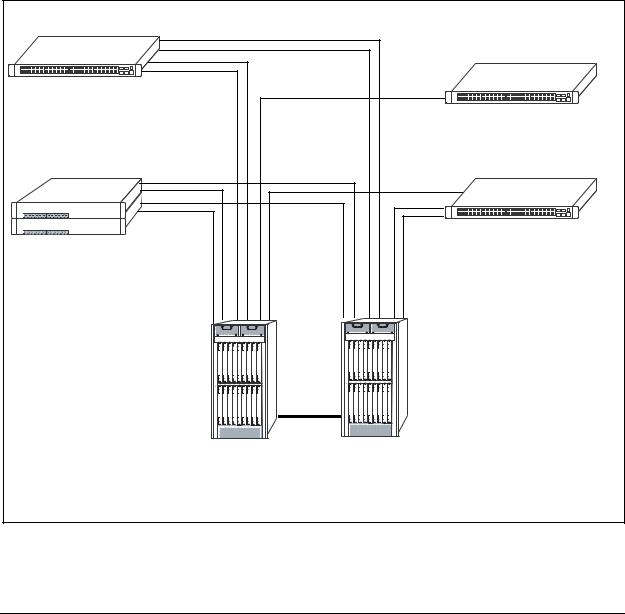
OmniSwitch 6800 Series Application Examples |
OmniSwitch 6800 Series |
|
|
|
|
OmniSwitch 6800 Series Application Examples
The following OmniSwitch 6800 Series applications are described below:
•Gigabit-to-the-desktop migration
•Server aggregation
•Layer 3 Aggregation/Distribution
•Small Enterprise core
Gigabit-to-the-Desktop Migration
OmniSwitch 6800 Series switches provide a migration path to Gigabit on the edge of the LAN. For example:
10/100/1000 Layer 2+ Switching |
10/100/1000 Layer 3 Switching |
OmniSwitch 6800 |
OmniSwitch 6800 |
Layer 2+ 10/100 Switching |
OmniSwitch 6800 |
Core Layer |
Application Example: Gigabit-to-the-Desktop Migration
page 1-8 |
OmniSwitch 6800 Series Hardware Users Guide June 2007 |
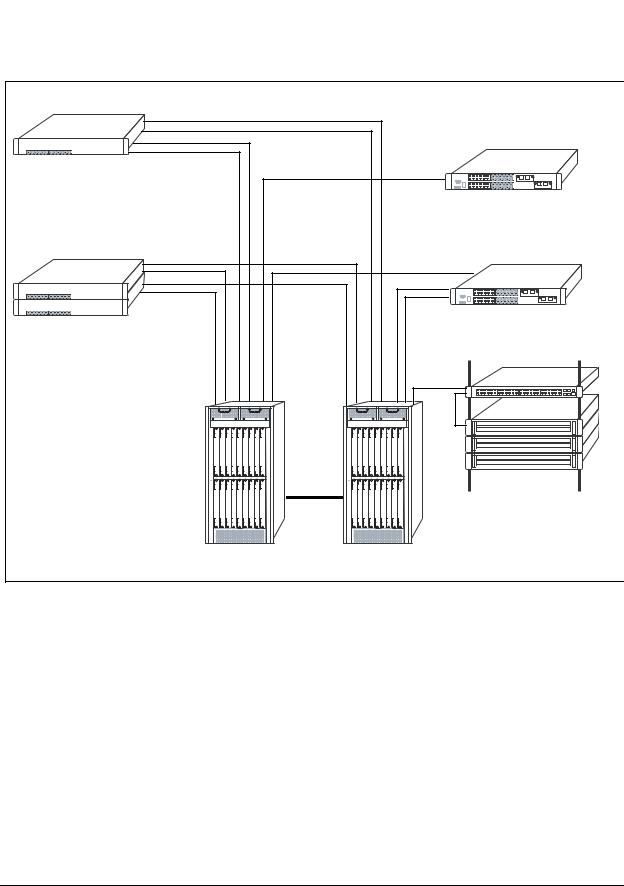
OmniSwitch 6800 Series |
OmniSwitch 6800 Series Application Examples |
|
|
|
|
Server Aggregation
The OmniSwitch 6800 Series switch is a well-suited server aggregation switch, especially for spaceconstrained data centers, where the switch can be installed in the same rack as the servers. For example:
10/100/1000 Switching |
10/100/1000 Switching |
OmniSwitch 6800 |
Servers |
Application Example: Server Aggregation
OmniSwitch 6800 Series Hardware Users Guide June 2007 |
page 1-9 |

OmniSwitch 6800 Series Application Examples |
OmniSwitch 6800 Series |
|
|
|
|
Layer 3 Aggregation/Distribution
OmniSwitch 6800 Series switches placed in the distribution layer of three-tier networks provide highcapacity, wire speed Layer 2 switching, Layer 3 routing, and intelligent services near the edge of the network. For example:
|
10/100 Switching |
|
Gigabit |
|
Uplinks |
OmniSwitch 6800 |
OmniSwitch 6800 |
Aggregation Layer |
|
(L2/L3 Switching) |
|
Multiple |
10 Gig |
10 Gig |
|
1 Gig |
|
|
10 Gig |
|
Core Layer |
|
(L3) |
Application Example: Layer 3 Aggregation/Distribution
page 1-10 |
OmniSwitch 6800 Series Hardware Users Guide June 2007 |

OmniSwitch 6800 Series |
OmniSwitch 6800 Series Application Examples |
|
|
|
|
Small Enterprise Core
With its high-speed switching capacity, supported Layer 3 routing protocols, advanced network services, and wire speed 10 Gigabit capability, the OmniSwitch 6800 Series provides effective core switching for smaller Enterprise networks (200-500 ports). For example:
10/100 layer 2 Switching |
|
10/100 layer 2 Switching |
|
|
|
10/100 layer 2 Switching |
Gigabit Uplinks |
|
|
|
|
OmniSwitch 6800 |
OmniSwitch 6800 |
|
Series Switch |
Series Switch |
|
Gigabit Layer 3 Switching |
Servers |
|
|
Internet |
|
|
Router |
|
|
|
Internet |
Application Example: Small Enterprise Core
OmniSwitch 6800 Series Hardware Users Guide June 2007 |
page 1-11 |

OmniSwitch 6800 Series Application Examples |
OmniSwitch 6800 Series |
|
|
|
|
page 1-12 |
OmniSwitch 6800 Series Hardware Users Guide June 2007 |

2 OmniSwitch 6800 Series
Chassis and Hardware
Components
OmniSwitch 6800 Series switches are available in five stackable chassis configurations—the 24-port OmniSwitch 6800-24 (OS6800-24), OmniSwitch 6800-U24 (OS6800-U24), OmniSwitch 6800-24L (OS6800-24L), the 48-port OmniSwitch 6800-48 (OS6800-48), and OmniSwitch 6800-48L (OS680048L). This chapter includes detailed information on these chassis types. Topics include:
•OmniSwitch 6800 Series chassis descriptions
•Technical specifications
•Mounting the switch
•Setting up a stacked configuration
•Booting OmniSwitch 6800 Series switches
•Monitoring the chassis
•Backup power supply components
•Monitoring backup power supply status
•Pinouts, power cord, and console port specifications
OmniSwitch 6800 Series Hardware Users Guide June 2007 |
page 2-1 |
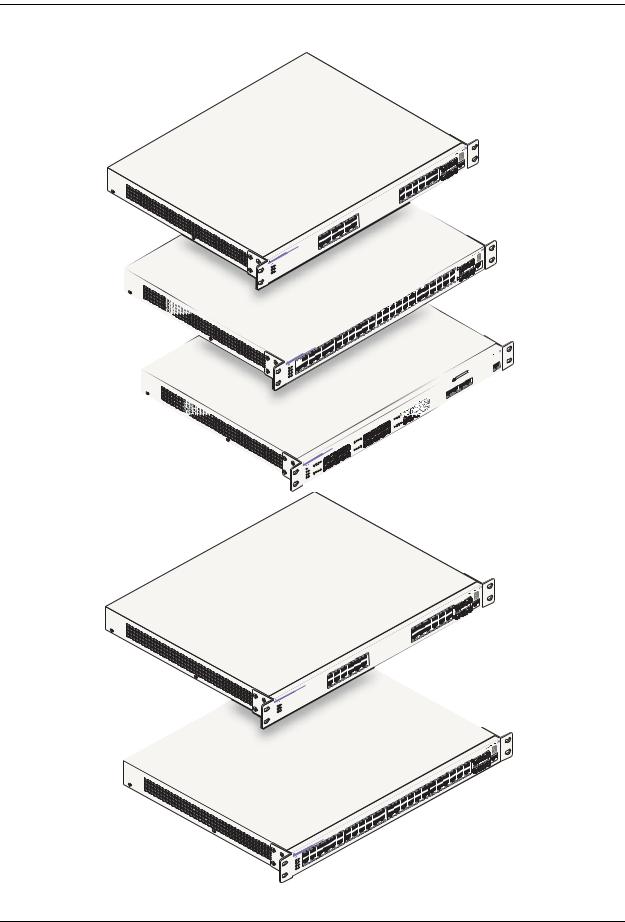
OmniSwitch 6800 Series Chassis and Hardware Components
-24 6800 OmniSwitch
-48 6800 OmniSwitch 
4 -U2 6800 OmniSwitch
|
800-24 |
L |
itch 6 |
|
|
|
|
|
OmniSw |
|
|
|
|
|
00-48 |
L |
|
iSwitc |
h 68 |
|
|
Omn |
|
|
|
|
OmniSwitch 6800-24 |
OmniSwitch 6800-48 |
OmniSwitch 6800-U24
OmniSwitch 6800-24L
OmniSwitch 6800-48L
page 2-2 |
OmniSwitch 6800 Series Hardware Users Guide June 2007 |
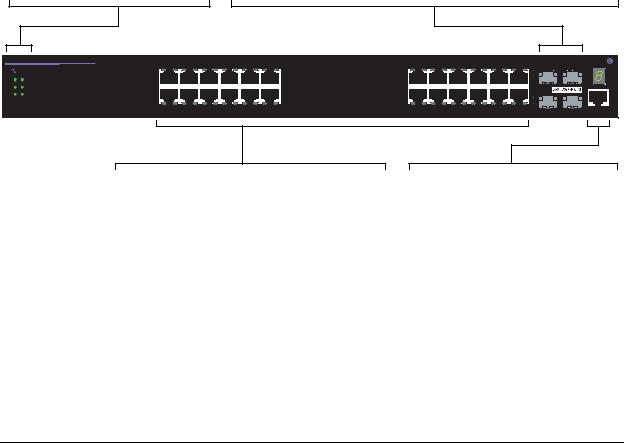
OmniSwitch 6800 Series Chassis and Hardware Components |
OmniSwitch 6800-24 |
|
|
|
|
OmniSwitch 6800-24
The OmniSwitch 6800-24 is a stackable edge/workgroup switch offering 24 10/100/1000Base-T ports, as well as four combo SFP connectors for high speed connections.
The front panel of the OS6800-24 chassis contains the following major components:
•System status and slot indicator LEDs
•(24) 10/100/1000Base-T ports
•(4) Combo SFP connectors for 1000Base-X connections
•Console port (RJ-45)
Refer to the illustration below for more front panel information. For detailed LED descriptions, refer to page 2-13. For information on the chassis rear panel, refer to page 2-15.
System Status LEDs
For detailed information on OS6800-24 system status and other LEDs, refer to page 2-13.
Combo SFP Connectors
The OS6800-24 provides four combo SFP connectors for 1000Base-X highspeed connections.
By default, when an SFP is installed in a combo port, it takes over the port number of the corresponding RJ-45 Ethernet port. In other words, if an SFP is installed in the slot labeled 24, Ethernet port 24 is no longer available and cannot be used for 10/100/1000 traffic. This default setting is referred to as “preferred fiber.” Refer to “Configuring Ethernet Ports” in the Network Configuration Guide for detailed information, including steps for configuring combo port settings.
 OmniSwitch 6800-24
OmniSwitch 6800-24
|
Speed |
1 |
3 |
5 |
7 |
9 |
11 |
13 |
15 |
17 |
19 |
21 |
23 LINK/ACT |
21 |
21 |
23 |
OK |
PRI |
|
|
|
|
|
|
|
|
|
|
|
|
23 |
|
|
|
|
|
|
|
|
|
|
|
|
|
|
|
|
|
||
PWR |
BPS |
|
|
|
|
|
|
|
|
|
|
|
|
|
|
|
FAN |
TMP |
|
|
|
|
|
|
|
|
|
|
|
|
22 |
|
|
|
Speed |
2 |
4 |
6 |
8 |
10 |
12 |
14 |
16 |
18 |
20 |
22 |
24 LINK/ACT |
24 |
|
|
22 |
24 |
Console |
10/100/1000Mbps Ports
The OS6800-24 provides 20 fixed 10/100/1000BaseT non combo ports (1–20) and 4 fixed 10/100/1000BaseT combo ports (21–24). These ports are auto-sensing and auto-MDIX and use RJ-45 connectors.
Console Port
The OS6800-24 front panel provides one RJ-45 port for console connections. Console connections are used by network administrators for switch management. This female RJ-45 connector provides a DTE console connection.
OmniSwitch 6800-24 Front Panel
OmniSwitch 6800 Series Hardware Users Guide June 2007 |
page 2-3 |

OmniSwitch 6800-24 OmniSwitch 6800 Series Chassis and Hardware Components
OS6800-24 Specifications
Total 10/100/1000Base-T ports |
24 |
per switch |
|
|
|
Total combo SFP connectors per |
4 |
switch |
|
|
|
Total 10/100/1000Base-T ports |
192 (stack of eight switches) |
per stack |
|
|
|
Total combo SFP connectors per |
32 (stack of eight switches) |
stack |
|
|
|
Fabric capacity |
160 Gbps |
|
|
Power |
150W AC/DC power supply, providing +12V @ 12.5A; |
|
90-264VAC50-60 Hz universal input |
|
|
Total available power supplies |
2 (one factory-installed power supply and |
|
one optional backup power supply) |
|
|
Flash memory size |
64 MB |
|
|
RAM memory size |
256 MB SDRAM |
|
|
Overall Width (rack-mount |
19 inches, approx. |
flanges included) |
|
|
|
Chassis Width (rack-mount |
17.32 inches |
flanges not included) |
|
|
|
Height |
1.73 inches |
|
|
Height (rack units) |
1 RU |
|
|
Chassis Depth |
16.73 inches |
|
|
Weight |
13.88 lbs. (6.30 Kg) |
|
|
Humidity |
5% to 90% Relative Humidity (Operating) |
|
0% to 95% Relative Humidity (Storage) |
|
|
Operating Temperature |
0 to 45 degrees, Celsius |
|
|
Storage Temperature |
-20 to 70 degrees, Celsius |
|
|
Altitude |
Operating altitude: sea level at 40 degrees, Celsius and |
|
10000 feet at 0 degrees, Celsius |
|
Storage altitude: sea level at 40000 feet |
|
|
page 2-4 |
OmniSwitch 6800 Series Hardware Users Guide June 2007 |
